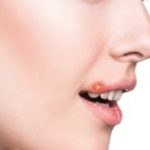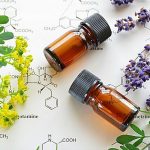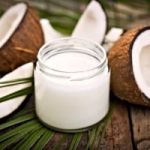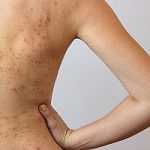Using Coconut Oil for Thrush and Yeast Infections

Studies show that fatty acids in coconut oil may have anti-fungal properties that could help fight thrush and yeast infections.
Yeast infections are commonly treated with anti-fungal medications called anti-mycotics.
Popular brands include Monistat, Gyne-Lotrimin and Vagistat. While many of these drugs effective, some people can experience side effects such as burning, stinging, swelling and irritation.
There are natural treatments that may offer relieve, including tea tree oil for candida, probiotic supplements, natural yogurt, boric acid, and even coconut oil.
This article will take a closer look at research on the fatty acids in coconut oil and their anti-fungal properties.
Research shows Fatty Acids in Coconut Oil Fights Candida

Coconut oils contain the fatty acids, Caprylic (capric) and Lauric acid.
These 2 fatty acids make up about 50% of the total fatty acid content in coconut oil.
Caprylic and lauric acid are also naturally found in a mother’s breast milk. They play a powerful role in helping to boost a growing baby’s immune system as well as establishing healthy growth factors.
Latest research shows that lauric and caprylic acid can effectively kill 3 different strains of candida.
How do Fatty Acids Fight Yeast Infections?
Researchers at the Center of Oral Health, University of Kentucky compared the antimicrobial activity of Lauric acid and Capric acid against different oral micro-organisms.
They found that lauric acid was more effective than capric acid against C. Albicans. And it so happens that C. Albicans is the strain of fungi responsible for causing candidiasis and some yeast infections. Researchers concluded that lauric acid can be an effective treatment for reducing the growth of yeast infections caused by C. Albicans.
A similar study published in the November 2001 edition of Antimicrobial Agents and Chemotherapy looked at the effects of capric and lauric acid on the C. albicans. Researchers found capric acid displayed the fastest and most effective kill rate of three strains of C. albicans. However, they found that lauric acid was actually more effective at lower concentrations and longer incubation periods.
When scientists at The Department of Medical Microbiology and Parasitology in Nigeria compared coconut oil’s fatty acids to prescription anti-fungal, fluconazole, they found coconut oils have 100% effectiveness against the Candida albicans strain.
And last, but not least, investigators at the Faculty of Pharmacy, University of Iceland performed a series of surface tests on monocaprin (a monoglyceride of caprylic acid) on various strains of micro-organisms, including C. albicans, E. coli and Pseudomonas aeruginosa. They found that the yeast organism, C. albicans, was the most sensitive to monocaprin and researchers believe it may be an effective agent for preventing yeast-borne oral infections.
How Can You Use Coconut Oil for Thrush and Yeast Infections?

Dr. William Crook, author of the book, The Yeast Connection: A Medical Breakthrough claims that doctors have used caprylic acid to successfully treat yeast infections.
He reports that coconut oils work well in patients who didn’t respond to traditional anti-fungal medications; or they experienced negative side effects from prescription drugs and chose to try an alternative method, such as coconut oils.
Although there are no documented medical studies on people who’ve used this coconut oil for thrush and candida, you can find internet testimonials from people who’ve successfully treated these types of infections.
Our research showed that many of these people started by ingesting 1 tablespoon of oil per day and then slowly increased the dosage each week until they were taking 3 – 4 tablespoons a day. Janet, from Australia, claims coconut oil cleared her staph infection after 48 hours.
However, there were some people that reported experiencing an increase in symptoms before getting better. This phenomenon has been called a ‘die-off’ or Herxheimer reaction. It’s believed that the rapid elimination of yeast overgrowth can flood the body with metabolic waste which may cause inflammation and a temporary ‘flare-up’ of symptoms. These symptoms may include increased fatigue, diarrhea, abdominal gas, headaches, sore throat and even joint pain.
A very popular site among Candida sufferers is Healing Naturally by Bee. She’s published two very popular articles on naturally healing Candida with coconut oil and other dietary/lifestyle changes.
Along with making appropriate food choices and lifestyle changes, Bee also provides information on using coconut oil for thrush and yeast infections and also how you can use these oils to naturally cure yourself.
You should know that due to the wide variety of symptoms seen in these types of conditions, you may or may not experience any results from using coconut oils for yeast or candida.
Please remember to consult your physician or health care provider before trying any alternative treatment for these types of health conditions.
Research References:
Short- and medium-chain fatty acids exhibit antimicrobial activity for oral microorganisms. Archives of Oral Biology. 2011 Jul;56(7):650-4.
In vitro killing of Candida albicans by fatty acids and monoglycerides. Antimicrobial Agents and Chemotherapy. 2001 Nov;45(11):3209-12
In vitro antimicrobial properties of coconut oil on Candida species in Ibadan, Nigeria.Ogbolu DO, Oni AA, Daini OA, Oloko AP. Department of Medical Microbiology & Parasitology, University College Hospital, Ibadan, Nigeria. Journal of Medicinal Food. 2007 Jun;10(2):384-7
Antimicrobial activity of monocaprin: a monoglyceride with potential use as a denture disinfectant. Acta Odontologica Scandinavica. 2006 Feb;64(1):21-6.
Caprylic acid in the effective treatment of intractable medical problems of frequent urination, incontinence, chronic upper respiratory infection, root canalled tooth infection, ALS, etc., caused by asbestos & mixed infections of Candida albicans, Helicobacter pylori & cytomegalovirus with or without other microorganisms & mercury. Acupuncture and Electrotherapy Research. 2011;36(1-2):19-64.
Home Page > Coconut Oil Home Page > Coconut Oil Candida





